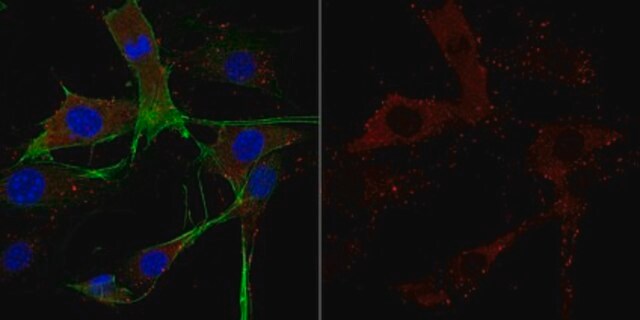C8736
Anti-Cofilin antibody produced in rabbit
IgG fraction of antiserum, buffered aqueous solution
Sinónimos:
Anti-CFL, Anti-HEL-S-15, Anti-cofilin
About This Item
Productos recomendados
biological source
rabbit
conjugate
unconjugated
antibody form
IgG fraction of antiserum
antibody product type
primary antibodies
clone
polyclonal
form
buffered aqueous solution
mol wt
antigen ~19 kDa
species reactivity
canine, rat, human, mouse
technique(s)
indirect immunofluorescence: 1:1,000 using using mouse NIH/3T3 fibroblasts
microarray: suitable
western blot: 1:10,000 using using whole extracts of human A-431, rat PC-12, mouse NIH/3T3, and dog MDCK kidney cells
UniProt accession no.
shipped in
dry ice
storage temp.
−20°C
target post-translational modification
unmodified
Gene Information
human ... CFL1(1072) , CFL2(1073)
mouse ... Cfl1(12631) , Cfl2(12632)
rat ... Cfl1(29271) , Cfl2(366624)
General description
Specificity
Immunogen
Application
- for immunostaining of chick neurons. It is used as a primary antibody
- for western blotting of protein isolated from mouse hippocampi cells, rat brain samples, human acute lymphoblastic T-cell line, human brain samples, head and neck squamous cell carcinoma cell line, HEK293T cells and renal epithelial cell lines
- for immunofluorescence studies in tissue samples from human brain
Biochem/physiol Actions
Physical form
Storage and Stability
Disclaimer
¿No encuentra el producto adecuado?
Pruebe nuestro Herramienta de selección de productos.
Optional
related product
Storage Class
10 - Combustible liquids
wgk_germany
WGK 1
flash_point_f
Not applicable
flash_point_c
Not applicable
Elija entre una de las versiones más recientes:
¿Ya tiene este producto?
Encuentre la documentación para los productos que ha comprado recientemente en la Biblioteca de documentos.
Nuestro equipo de científicos tiene experiencia en todas las áreas de investigación: Ciencias de la vida, Ciencia de los materiales, Síntesis química, Cromatografía, Analítica y muchas otras.
Póngase en contacto con el Servicio técnico








